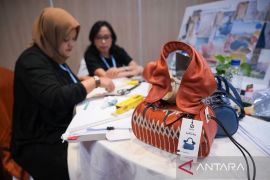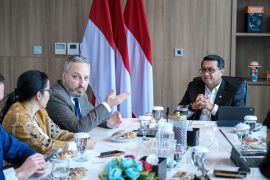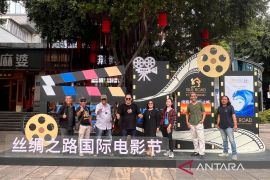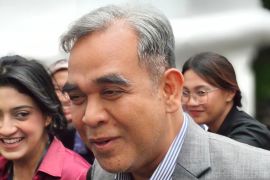An estimated 24,000 workers are engaged in the animation industry sector.Jakarta (ANTARA) - South Korea's success in driving its economic performance to become a developed nation, which is recognized globally for its creative economy sector, should serve as a guide for all.
Also, the K-Pop culture has grown into a full-fledged genre of its own and gained immense popularity and is admired by many youngsters across the world. Its culture infiltration is a growing phenomenon.
South Korea has, in fact, robustly transformed its art and culture into a creative industry that is able to be sold and adored by anyone.
Witnessing South Korea’s success in the industry, Indonesia has the identical potential to attain a similar level in terms of the creative economy, considering the prospects it holds in the form of the young generation.
Coordinating Minister for Economic Affairs Airlangga Hartarto believes that millennials, who are creative entrepreneurs, can help the Indonesian government to develop the country's creative industries.
Hartarto noted that the creative industry was one of the sectors expected to support the nation’s economic growth and to drive revival of the economy affected by the pandemic.
Related news: Vaccination rates will drive reopening of tourism destinations: govt
He believes that the world views Southeast Asia as a huge market that is supported by its population and economic and political stability. This potential should be utilized optimally, including for the development of creative and digital industries, he remarked.
Especially in the midst of a pandemic, there is a "magic box" technology product called smartphones. Entertainment demands continue to increase, so it must be harnessed with the inclusion of creative content, he pointed out.
He called for prompt efforts to boost virtual products and not just the physical objects.
Hartarto also noted that the government had accommodated and mandated endeavors to develop the creative and digital economy through several policies and regulations, including Law No. 11 of 2020 on Job Creation, with derivatives in the form of Government Regulation No. 7 of 2021 on Ease, Protection, and Empowerment of Cooperatives and MSMEs through the strengthening of entrepreneurial incubators.
Creating Opportunities
Related news: Tourism budget refocusing leaves 58 percent of total initial ceiling
Several entrepreneurial policies and development strategies pertaining to the creative economy implemented by the government aim to boost business capacity and financing access for entrepreneurs, increase business and start-up opportunities, and boost the added value of social efforts.
As an illustration, Statistics Indonesia's data in 2018 indicated that the creative economy sub-sector had a major contribution to the national economy at 7.44 percent to the Gross Domestic Product (GDP), 14.28 percent to labor, and 13.77 percent to exports.
According to the data, about 8.2 million creative businesses in Indonesia are engaged in culinary, fashion, and craft, and these three sub-sectors are the largest contributors to the creative economy's contribution to the GDP.
In addition, four sub-sectors with the fastest growth are TV and radio; film, animation, and video; performing arts; and Visual Communication Design.
The animation sector has wide potency in opening opportunities and creating labor with capability, and qualified human resources can be derived from vocational high schools, the minister remarked.
The above situation applies to animation companies that their business scales, based on the number of human resources, are more than 50 workers, he added.
According to the data, 120 Indonesian animation studios employ 5,771 creative workers chiefly of the younger generation, the minister remarked.
It is estimated that approximately 24,000 workers are engaged in the animation industry sector. That means the animation sector is one of the major labor-intensive and capital-intensive creative industries.
The coordinating minister seeks to accommodate the proposals of animation industry players to realize them.
Related news: Uno optimistic of youngsters taking part in creative economy industry
Hartarto affirmed that the government will support the ideas, as it is also related to human resource development and is in accordance with the momentum of digitalization.
He is optimistic of capitalizing on the momentum of this digitalization and exchanging ideas in discussing joint efforts to further build the Indonesian creative economy.
Creative business players are optimistic that the government would coordinate with various agencies related to Indonesia's creative industry ecosystem to formulate joint policies in supporting positive growth of the creative economy through an end-to-end approach.
Collaborating with South Korea
Minister of Tourism and Creative Economy Sandiaga Salahuddin Uno continues to encourage the rise of the animation industry in the country.
Uno explained that his side currently intends to build the digital economy ecosystem by inviting those from the animation sectors to work with the toy industry.
He also lauded the country's creative economy players, especially the animation sector, that have remained productive at work during the pandemic.
Several efforts to bolster the expansion of the animation industry were made not only by the government but also others, including the Korea Creative Content Agency (KOCCA) Indonesia that earlier organized the K-Content BizWeek 2021.
Related news: Be innovative to develop tourism and creative economy: Minister Uno
The online event, held on August 24-25, 2021, aimed to bring together South Korean and Indonesian animation industry businesses. Some 25 South Korean animation companies attended the event.
Most of the companies have produced children's animation products: ANYZAC, with its work "Zombie Dumb", DOFALA, with one of its works "Nano Ranger TV Series", Tak Toon Enterprise "Big Five", and STUDIO GALE, with its two famous works "Pororo The Little Penguin" and "Tayo The Little Bus".
Some 29 Indonesian companies were also present at the K-Content BizWeek 2021. The companies at the event shared the same interest in Intellectual property (IP) and animation.
Furthermore, six Korean animation companies that conducted IP Screening online at the event. Live streaming was organized on K-Content Pavilion's YouTube account, with Kim Young Soo as the host.
At the peak of the event, a memorandum of understanding (MoU) will be inked between PT. Hidayah Insan Mulia with PANDE and PT. Lingkar Media Kreatif Indonesia with DOFALA.
Not only companies, but associations, such as KAIA (Korea Animation Industry Association) and AINAKI (Association of Indonesia Animation Industry), will also sign an MoU.
The companies that will sign the contract are PT. Triyakom with PANDE and PT. Lingkar Media Kreatif Indonesia with DOFALA.
A similar event was held by KOCCA Indonesia a few months ago. Changes in lifestyle and content consumption since the onset of the pandemic are among the contributing factors to hold this business meeting.
The determination in promoting the animation industry is expected to motivate local animation creative players to seize big opportunities that hold vast possibilities for the country.
Related news: Tourist attractions must use PeduliLindungi tracing app: minister
Related news: President expects continued GDP, economic improvement in Q3
Copyright © ANTARA 2021












